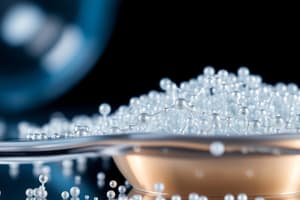Podcast
Questions and Answers
What percentage of the global GDP in 2020 was estimated to be the annual cost of fighting corrosion?
What percentage of the global GDP in 2020 was estimated to be the annual cost of fighting corrosion?
- 3.4% (correct)
- 3.0%
- 2.4%
- 4.1%
Why are industrial paints and coatings important?
Why are industrial paints and coatings important?
- They are an alternative to raw metal use.
- They significantly reduce manufacturing costs.
- They reduce the impact of corrosion and extend lifespan. (correct)
- They are primarily used for decorative purposes.
What improvement percentage in scribe creep was observed in graphene coatings compared to control coatings?
What improvement percentage in scribe creep was observed in graphene coatings compared to control coatings?
- 50%
- 70%
- 55%
- 62% (correct)
What is one characteristic of smooth, cold-rolled steel concerning anticorrosive coatings?
What is one characteristic of smooth, cold-rolled steel concerning anticorrosive coatings?
What application is Swift Coat primarily focused on with their TiO2-based nanocoatings?
What application is Swift Coat primarily focused on with their TiO2-based nanocoatings?
What makes graphene a notable material for anticorrosive properties?
What makes graphene a notable material for anticorrosive properties?
In the research conducted by Sparc Technology, what method was used to test the coatings' performance?
In the research conducted by Sparc Technology, what method was used to test the coatings' performance?
What was identified as a common challenge for coatings on cold-rolled steel?
What was identified as a common challenge for coatings on cold-rolled steel?
Which nanoparticle is specifically used for antimicrobial protection in paints?
Which nanoparticle is specifically used for antimicrobial protection in paints?
What is one of the primary concerns associated with the use of nanotechnology in paints?
What is one of the primary concerns associated with the use of nanotechnology in paints?
What is the primary benefit of incorporating nanoparticles into paints?
What is the primary benefit of incorporating nanoparticles into paints?
Which company is known for its Nano-Ceramic Paint that enhances scratch resistance?
Which company is known for its Nano-Ceramic Paint that enhances scratch resistance?
What property does nanosilver powder provide to paints?
What property does nanosilver powder provide to paints?
In which area is nanotechnology NOT typically applied according to the document?
In which area is nanotechnology NOT typically applied according to the document?
Which nanoparticle is utilized to improve the barrier properties and durability of paints?
Which nanoparticle is utilized to improve the barrier properties and durability of paints?
What method is used to synthesize silver nanopowder in an eco-friendly way?
What method is used to synthesize silver nanopowder in an eco-friendly way?
Why is silica used in the synthesis process of silver nanopowder?
Why is silica used in the synthesis process of silver nanopowder?
Which of the following is a challenge in hospitals related to cleanliness?
Which of the following is a challenge in hospitals related to cleanliness?
What is one potential application of silver nanopowder besides use in paints?
What is one potential application of silver nanopowder besides use in paints?
What is the size range of nanoparticles used in the paint industry?
What is the size range of nanoparticles used in the paint industry?
What type of environment does the incorporation of nanoparticles into paints aim to protect against?
What type of environment does the incorporation of nanoparticles into paints aim to protect against?
What can be the maximum reduction in solar panel efficiency due to soiling over time?
What can be the maximum reduction in solar panel efficiency due to soiling over time?
What is the primary benefit of applying titanium dioxide-based nanoparticles to solar panels?
What is the primary benefit of applying titanium dioxide-based nanoparticles to solar panels?
What does the aerosol impact-driven assembly (AIDA) process primarily accelerate?
What does the aerosol impact-driven assembly (AIDA) process primarily accelerate?
What unique property do nanomaterials add to paints and coatings?
What unique property do nanomaterials add to paints and coatings?
Which of these is not listed as a benefit of using nanotechnology in paints?
Which of these is not listed as a benefit of using nanotechnology in paints?
What is one of the potential applications of titanium dioxide particles besides improving solar panel efficiency?
What is one of the potential applications of titanium dioxide particles besides improving solar panel efficiency?
Which characteristic is associated with nanomaterials used in paints?
Which characteristic is associated with nanomaterials used in paints?
What is a drawback of not cleaning solar panels due to accessibility issues?
What is a drawback of not cleaning solar panels due to accessibility issues?
Flashcards are hidden until you start studying
Study Notes
How Nanoparticles Enhance Paint
-
Nanoparticles are being used to improve paint properties, offering benefits like greater protection against corrosion and antimicrobial properties.
-
Nanoparticles are particularly advantageous for businesses interested in highly effective coatings.
Antimicrobial Properties of Silver Nanoparticles
-
Silver is a well-known antimicrobial agent that inhibits microbial cellular functions and kills bacteria and fungi.
-
Researchers are experimenting with nanosilver powder mixed with paint to create antimicrobial coatings, particularly for hospitals and healthcare providers.
New Techniques for Synthesizing Silver Nanopowder
-
A team of Indian researchers at the Bhabha Atomic Research Centre (BARC) has developed an environmentally friendly method for synthesizing silver nanopowder.
-
The method minimizes the use of harsh chemicals and attaches silver nanoparticles to a silica substrate using gum arabic, an eco-friendly biopolymer derived from acacia tree sap, to prevent their release into the environment.
-
The synthesized silver nanopowder can not only provide paints with antimicrobial properties but is also applicable in waste management and water purification.
Nanotechnology Prevents Corrosion
-
Corrosion is a significant issue, costing the world an estimated $2.5 trillion annually for inspection, replacement, and protection.
-
Nanotechnology has created new paints and coatings that resist corrosion, extending the lifespan of metal parts.
Fighting Corrosion with Graphene Paints and Coatings
-
Research by Sparc Technology has revealed graphene's promising anticorrosive properties when mixed with commercially available coatings and paints.
-
Graphene, a super-thin material composed of carbon atoms in a lattice-like structure, significantly improves corrosion resistance.
-
Tests using graphene coatings on steel substrates showed a 62% improvement in scribe creep compared to control coatings after 1,344 hours of salt spray exposure.
-
Graphene coatings are particularly effective on challenging substrates like cold-rolled steel, typically more difficult for coatings to adhere to.
Dust-Repellent Coatings with TiO2-Based Nanomolecules
-
TiO2-based nanocoatings are effective at controlling dust and dirt in UV-exposed environments.
-
Swift Coat has developed a nanoparticle delivery system for creating dust-repellent coatings for solar panels, improving their efficiency and reducing maintenance needs.
-
TiO2-based nanocoatings can prevent soiling on solar panels, which can reduce efficiency by up to 30% over time.
-
TiO2 nanoparticles catalyze UV light to decompose airborne dirt and dust particles, slowing or preventing soiling.
-
Swift Coat's AIDA nanomaterial deposition method accelerates aerosolized nanoparticles to attach to substrates, allowing for control of coating porosity and thickness.
-
This process helps reduce reflectivity, further increasing solar panel efficiency.
Titanium Dioxide Anticorrosive Properties
- Similar to graphene, titanium dioxide exhibits anticorrosive properties, making it applicable in preventing corrosion of metal parts.
Nanomaterials' Impact on the Paint Industry
-
Nanomaterials offer unique properties like antimicrobial, anticorrosive, and dust-repellent qualities, benefiting a diverse range of industries.
-
While the use of nanomaterials in paints is still mostly experimental, several commercial applications demonstrate the potential of nanotechnology to revolutionize paint coatings.
-
The advantages of incorporating nanoparticles outweigh the costs, leading to longer-lasting and more efficient end products.
Studying That Suits You
Use AI to generate personalized quizzes and flashcards to suit your learning preferences.




